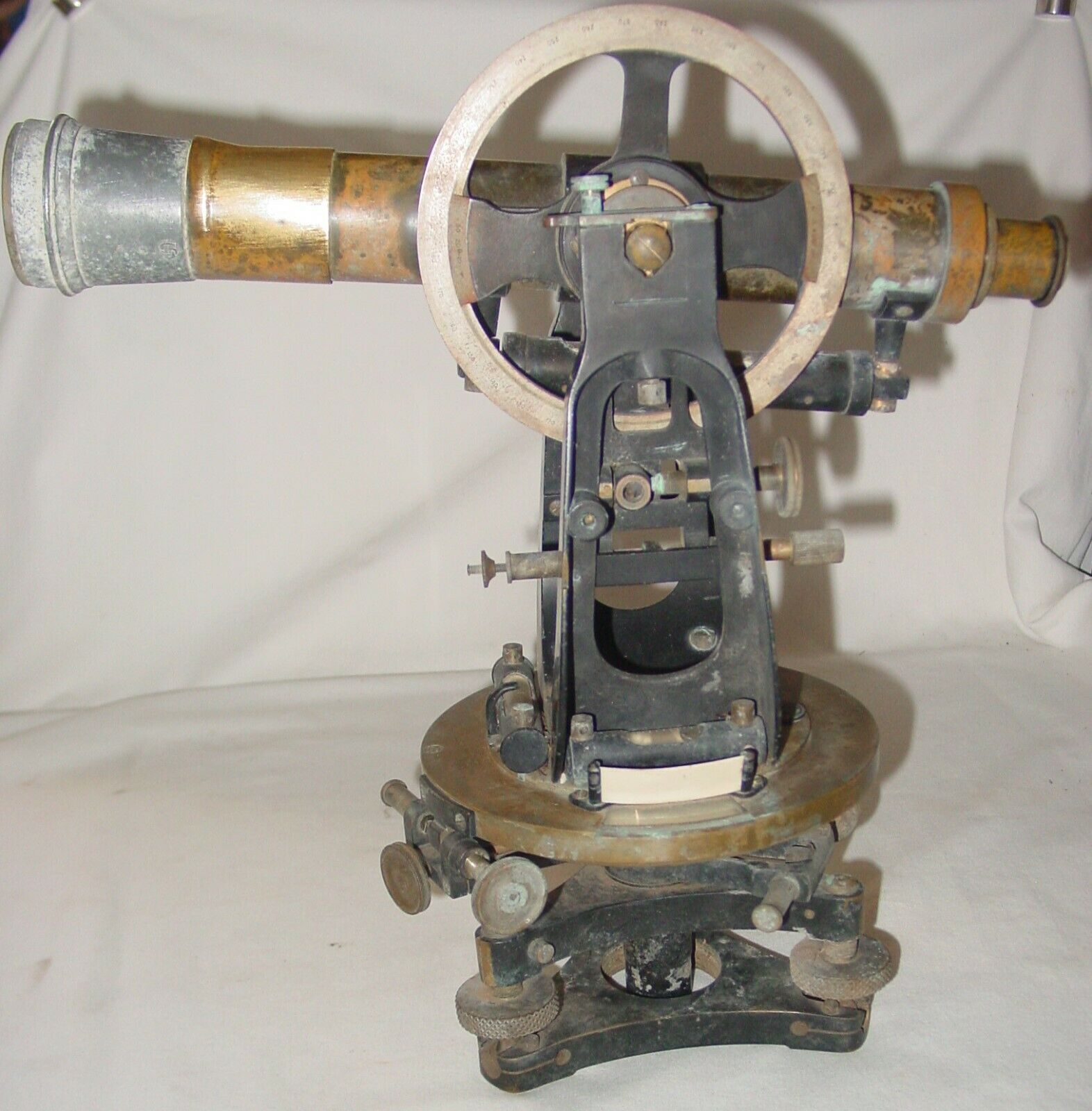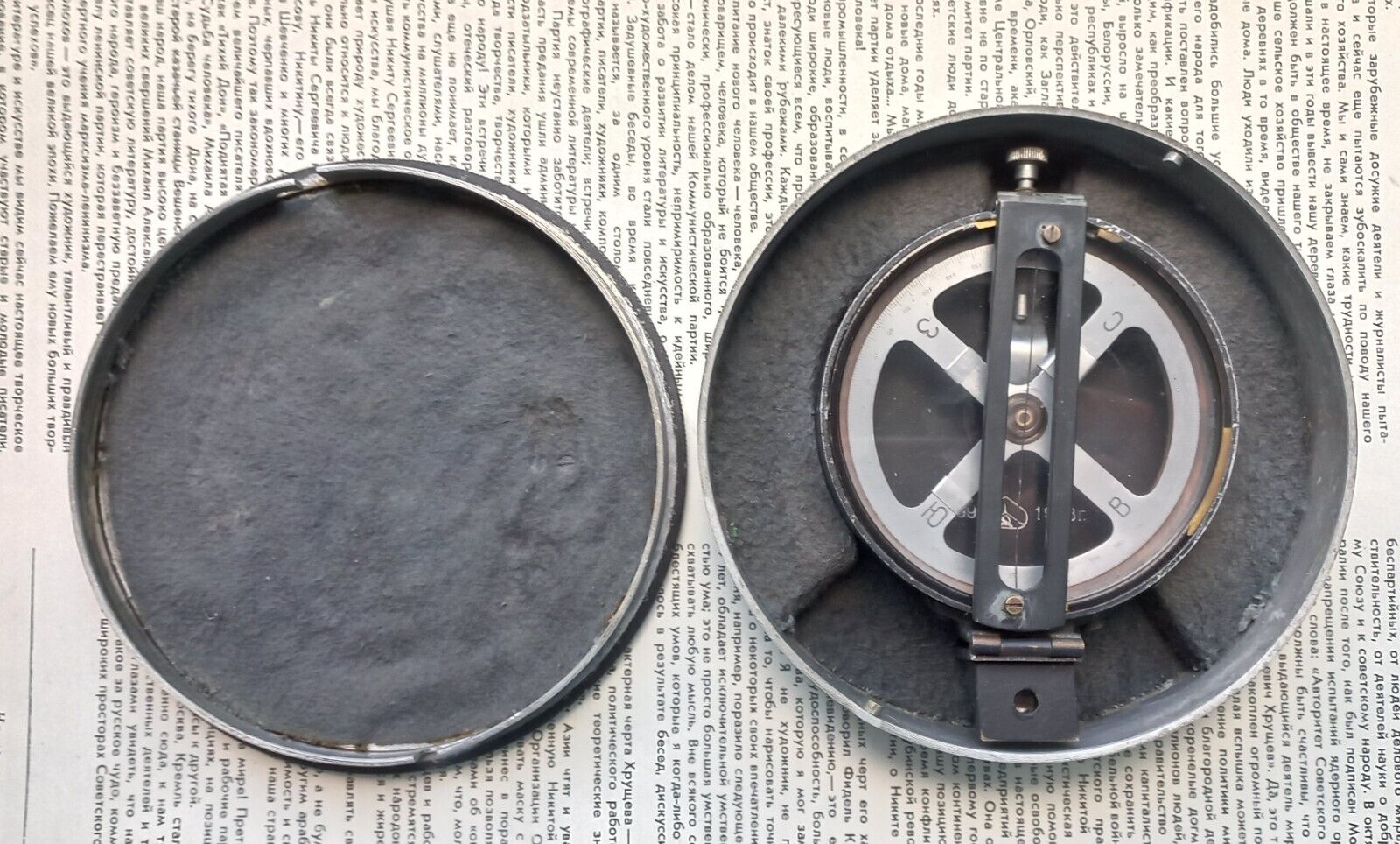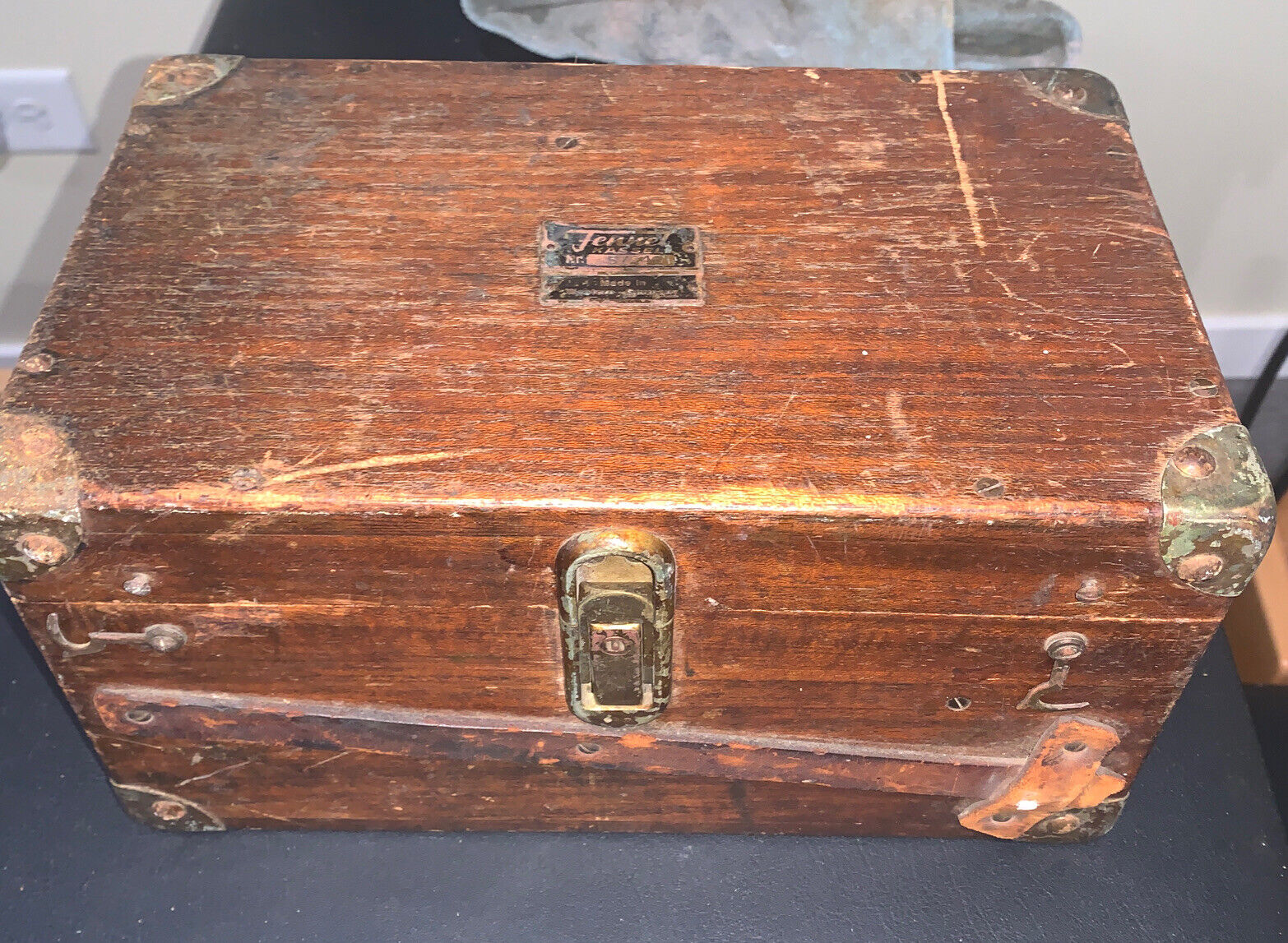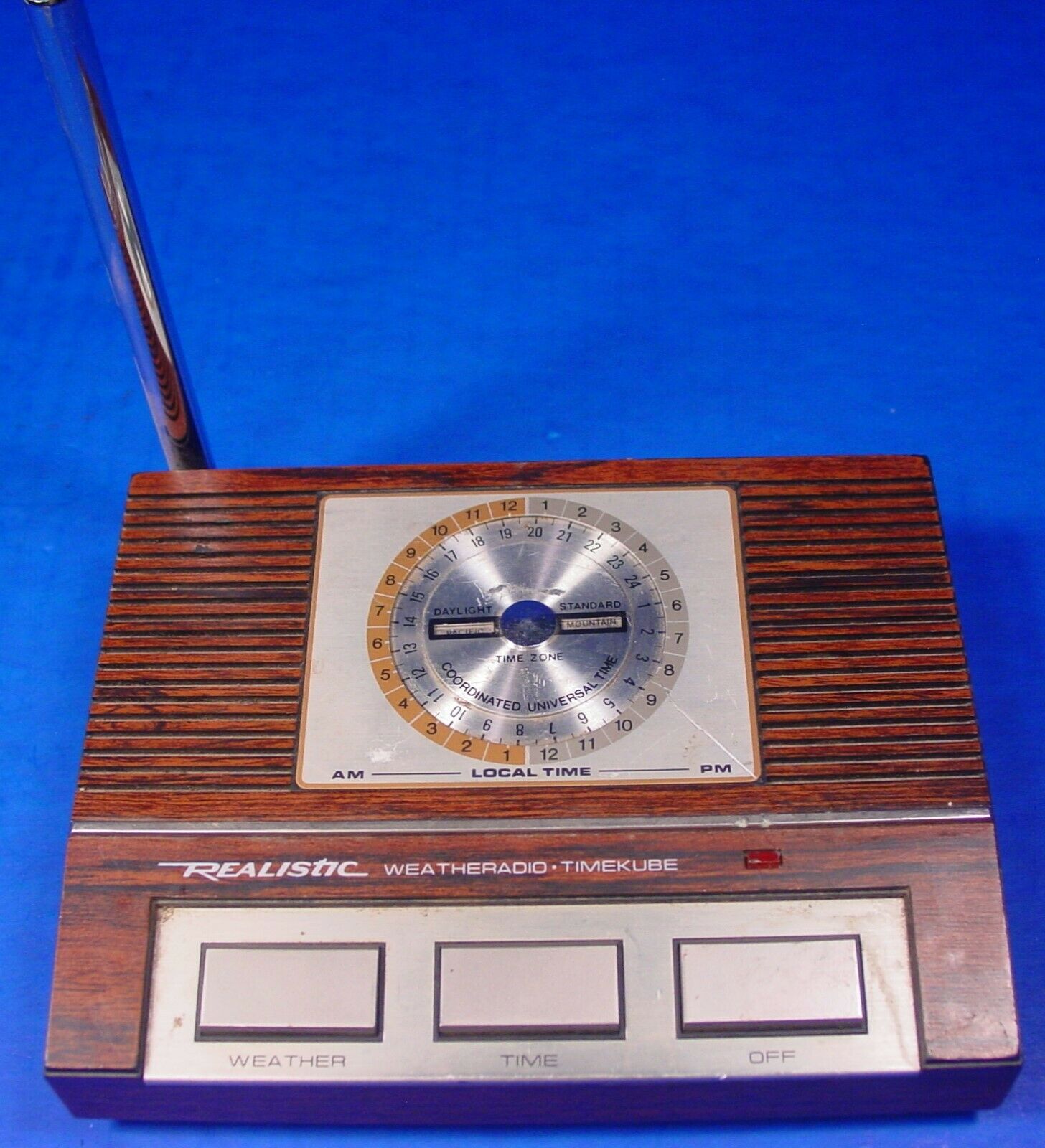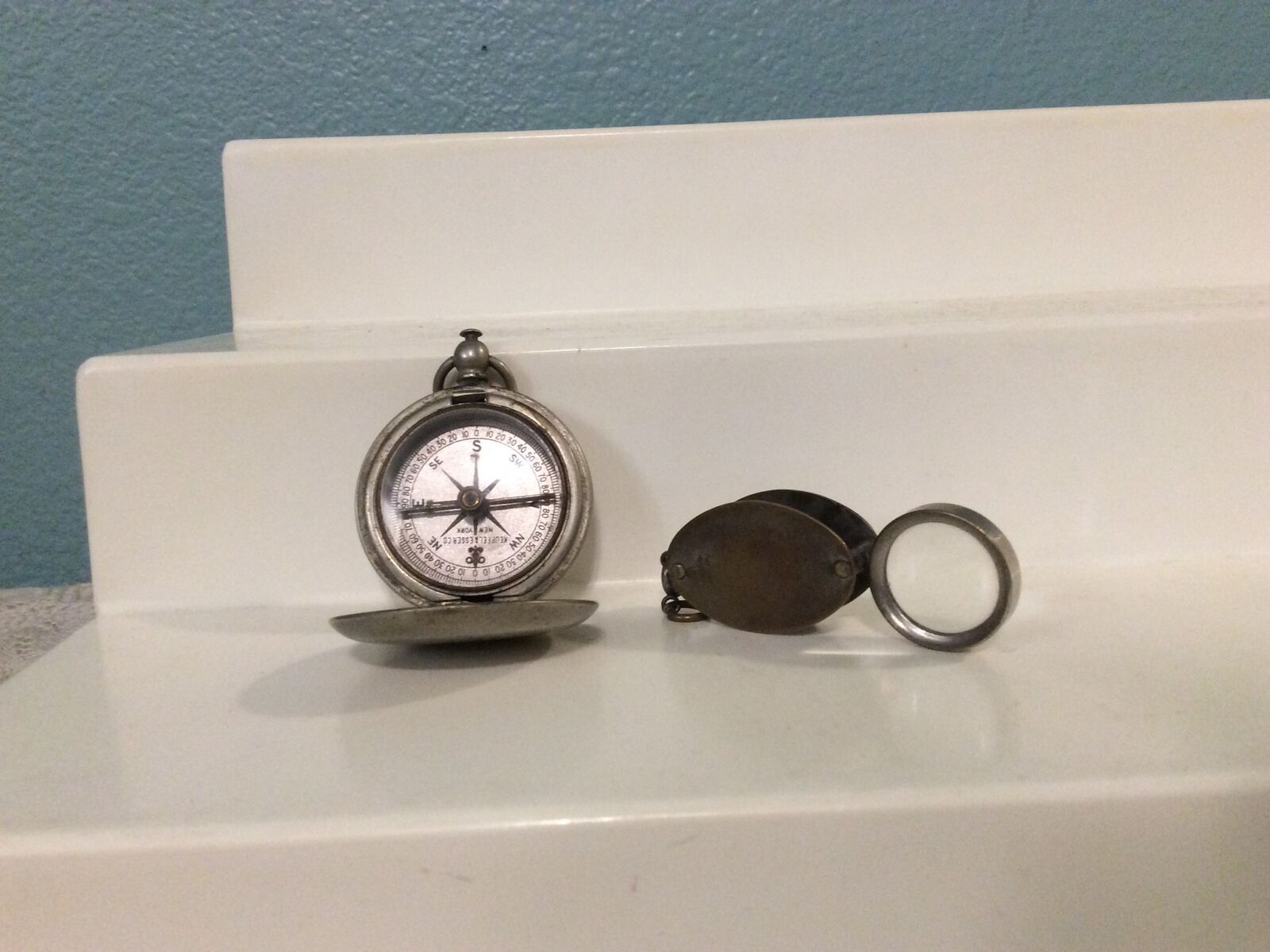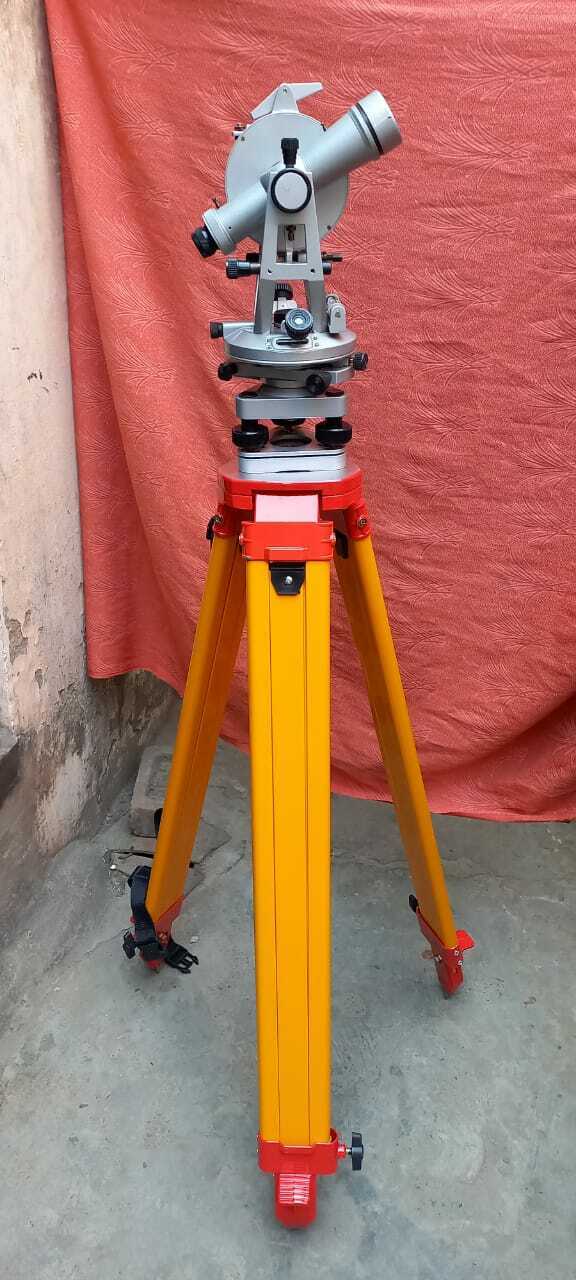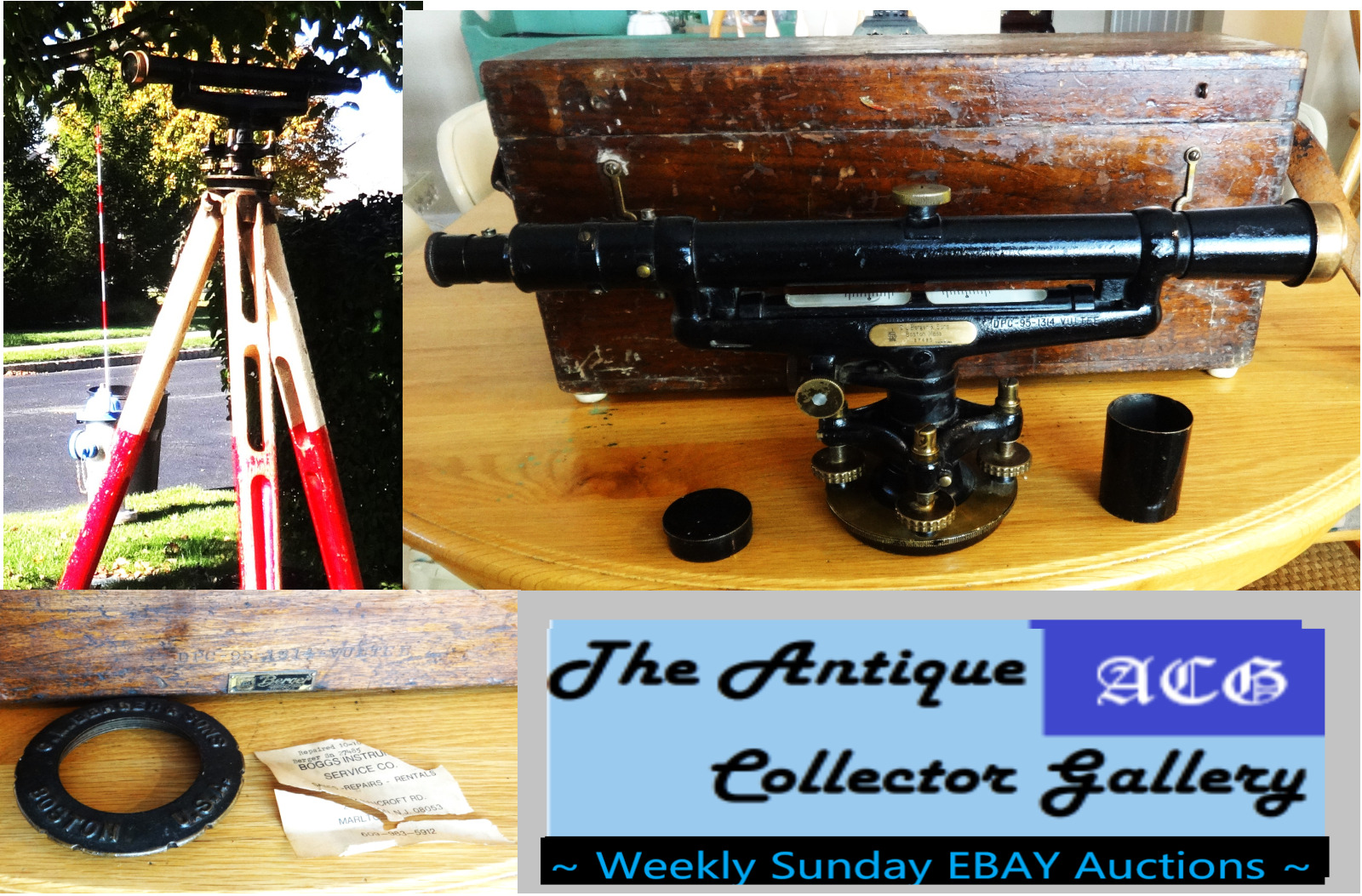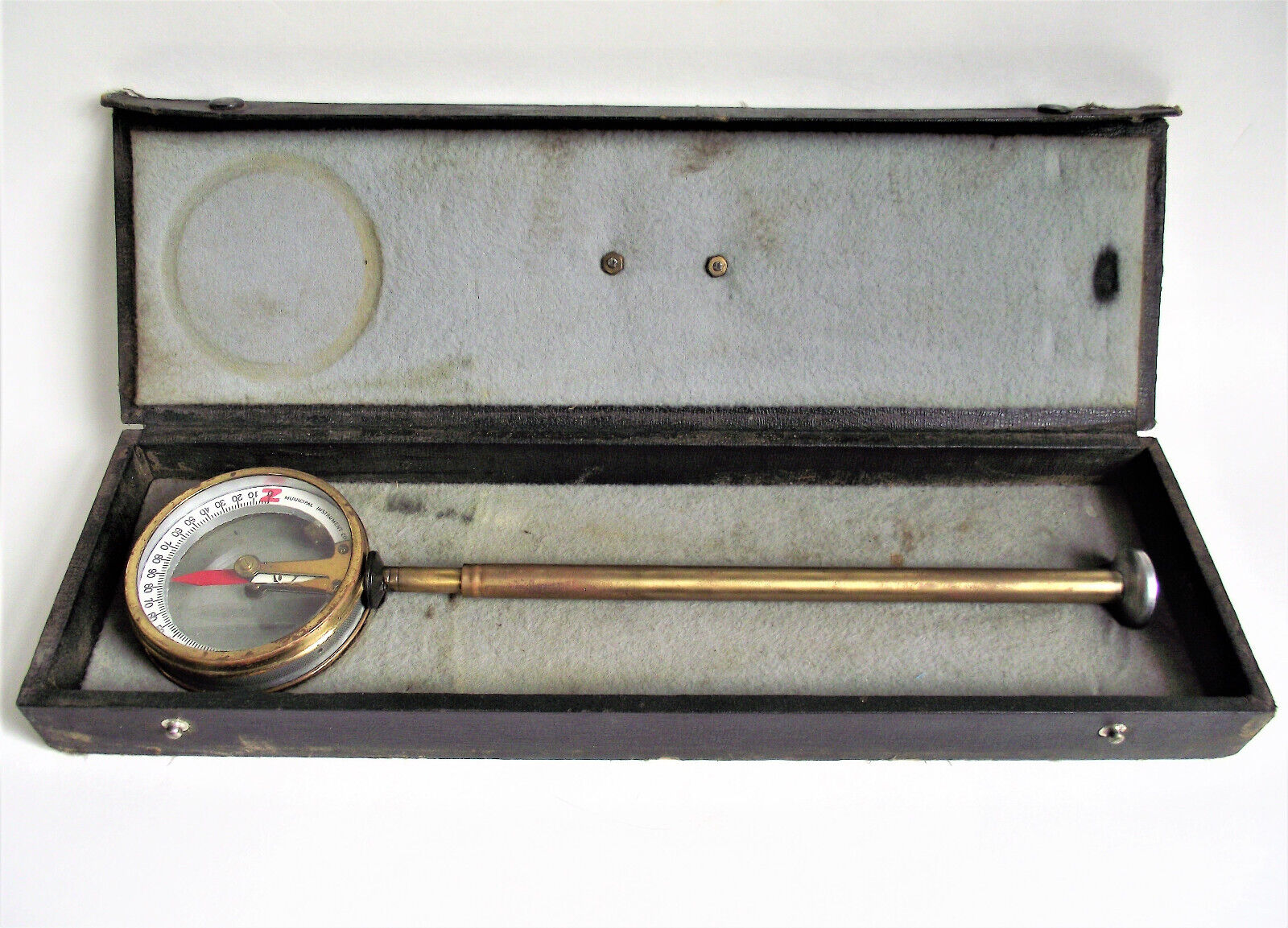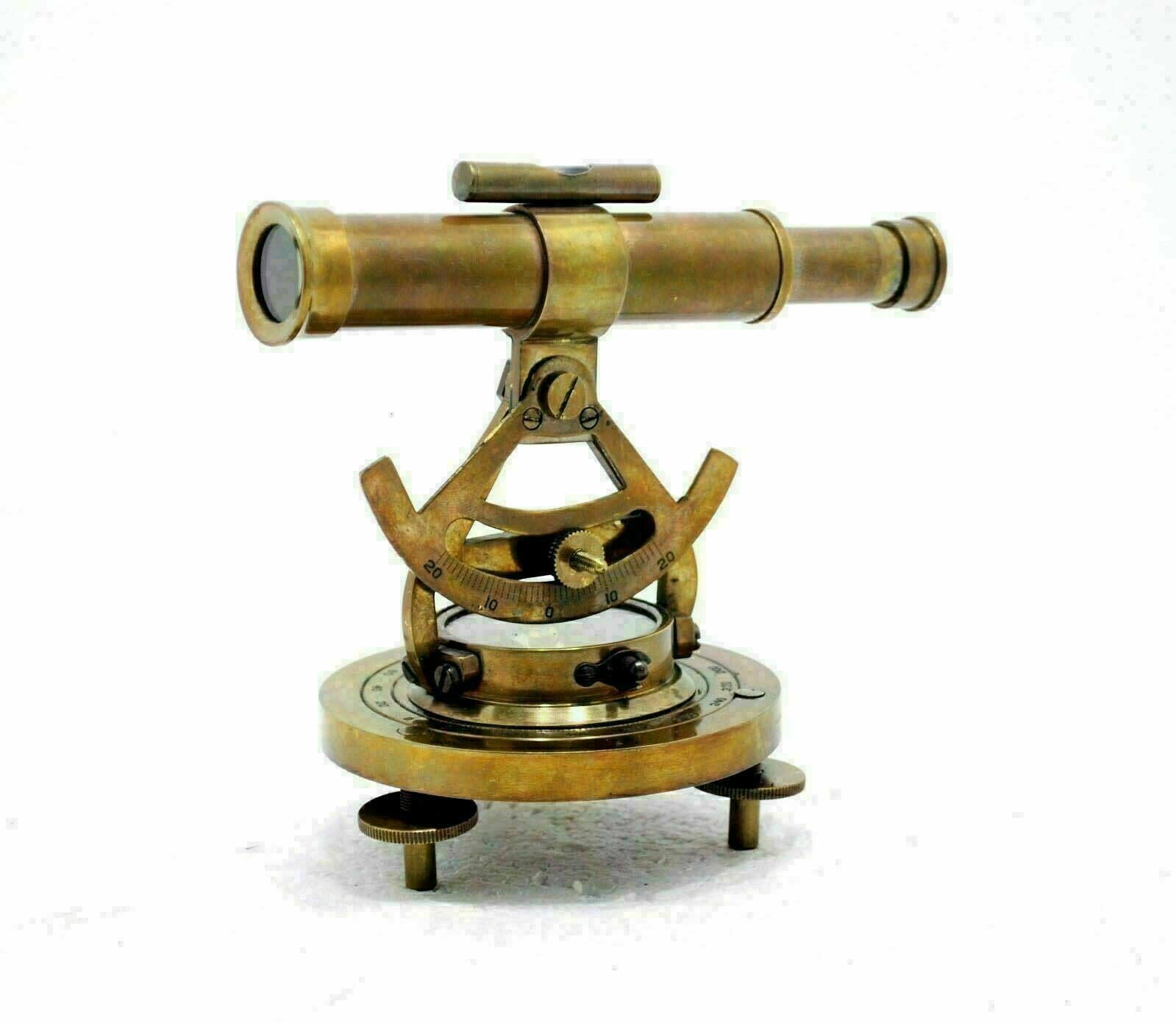-40%
1910 Bausch Lomb Survey Theodolite mkd. Topley Co. Ottawa Canada
$ 184.8
- Description
- Size Guide
Description
This is a Bausch and Lomb theodolite in pretty rough condition, has quite a bit of oxidation on it. I bought it intending to make a project of dismantling it and cleaning off the oxidation, but I have to many projects so will leave that to the new owner. It has inverted optics in good shape, cannot see cross hairs but the focus nob is missing so not sure about them (if so desired I know a great transit repair guy that can replace the focus nob). The scope on this is 11 1/4" long and the plate is 5 inches, it reads direct to 1 minute of arc. The scope will only transit on this one direction making this a theodolite rather than a transit. It has a unique leveling base that was very advanced for the time it was made, and has a nice tag on it identifying the original owner or retailer Topley Co. Ottawa Canada. Except for the missing focus nob everything is working as it should, just needs some cleaning and oiling of the main parts.Postage is .00 if within the US, more If you are outside the US; no charge for careful packing.
Here is some information on the well known maker Bausch and Lomb:
Bausch & Lomb Company
R' JOHN J. BAUSCH, the founder of the Bausch & Lomb Optical Company,
was born in Gross Suessen, Wuertemberg, on July 25, 1830, When he was fourteen, his parents apprenticed him to his brother, who was an optician, and with him he served three and a half years. Then he went to Berne and learned what the Swiss opticians had to teach him, staying among them till the spring of 1849. But his ambitions looked towards the New World and, in the summer of the same year, he crossed the Atlantic, landing in New York in the latter part of June. He found the city crowded with immigrants and no work was to be had. So he turned his face towards Buffalo. Here, too, the outlook was gloomy. The city was cholera stricken and everyone who could leave had done so. Work as a kitchen boy was all he could find, and this humble avocation had to content him fur three months. But it gave him time to look around. For opticians there was no demand; but Mr. Bausch's apprenticeship had included wood-turning, and this knowledge found him employment. Thinking that Rochester might oiler a fairer field, he came here in 1850, only to find, however, that, if he were to gain a livelihood, it must be as a wood
-
turner. For three years he continued this work, married, and seven weeks after the wedding was deprived of two fingers of the right hand by an accident. That a
c
cident, which ended his career as a wood-turner, was a blessing in disguise, for it made him fall back on the work for which he was best fitted.
Rochester had now some forty thousand inhabitants, and to Mr. Bausch it seemed to offer an excellent field for an optician. So he bravely embarked in business, renting half of a shoe window in the gallery of Reynold's Arcade. It was unostentatious enough in all conscience, but it was the beginning of an enterprise that was to make Rochester the optical center of the world. Shoes and optical good were exhibited aide by aide, in
strange
companionship. The income was wretchedly small, and again and again Mr. Bausch was tempted to give up in despair. But he kept doggedly on and rented a better location on the ground floor of the Arcade. Many were the weeks in which he did not take in more than a few dollars and, if it had not been for help from his family in Germany, he would have been forced
to end the fight.
One of Mr. Bauach's companions in these early days was Mr. Henry Lomb, like himself, a native of Germany, born in Burghaun, Hesse-Cassel, November 24. 1828. Mr. Lomb had crossed the ocean a month ahead of Mr. Bausch lind gravitated directly to Rocheater. He had saved 60 dollars and this sum he lent his friend. The two men agreed that as soon as the business warranted it, Mr. Lomb should join the firm as half partner. It was in 1855 that Mr. Lomb' a active association with the undertaking began. In order to widen his field of operations Mr. Bausch decided to visit the neighboring towns. To enable him to do so, he called on Mr. Lomb to attend to the business in Rochester. Good success attended the excursions and, when Mr. Lomb had learned to fit eyes, he too took to the road. In spite of this success, however, the firm's income was still barely sufficient for two men to live upon.
His
natural drift of scientific and economic tendencies has led to the fusion of business interests of the Bausch & Lomb Optical Company, the Bausch, Lomb, Saegmuller Company, both of Rochester, and the Carl Zeiss Optical Works of Jena. This unification is the practical expression of a desire to concentrate the knowledge, skill, experience, and energy of the leading optical firms of two continents. Under the new regime the Bausch, Lomb, Saegmuller Company becomes an integral part of the Bausch & Lomb Optical Company, losing its identity as a separate corporation.
The Zeiss Works become members of the new corporate organization, and the intention is to manufacture certain products of the Jena Works in the United States. While the interests of the firm of Zeiss in the United States therefore become one with those of the Bausch & Lomb Optical Company, yet the Zeiss Works are legally bound to maintain in perpetuity their entity at Jena in accordance with the conditions laid down by Professor Abbe when providing for their future, and the laws of Germany have made his intentions binding. The new company, to be known as the Bausch & Lomb Optical Company, thus unites the progressive spirit and integrity, the scientific genius and ingenuity of the firms allied.
By 1856 Mr. Bausch felt sufficiently strengthened in his position to go to Europe, make purchases of optical goods, and establish relations with producing houses on the other side. When he returned, he went on experimenting particularly with a view to finding a material which would replace horn, which was in common use for frames, but undesirable on account of iu tendency to split. One day he chanced to find a piece of vuleanite. He tested the then new material in every direction and its suitability for eyeglasses was established. The making of rubber eyeglasses was the firm's first constructive success. First the new eyeglasses were used for the firm's own private business and later to supply the trade. But the frame, though an integral part of the eyeglass, was not Mr. Bausch's primary interest. It was the optical side of the business that he cared for above everything else. He started business with the predetermined idea of grinding lenses for the whole field of optics, whether for spectacles, telescopes, microscopes, or the camera. The taking up of these various phases of optical work had necessarily to be left to expediency and the demands of the times; but the preconceived ideal to cover the whole optical field was there; it was Mr. Bausch's dream as a young man; it was his occupation in maturity; it is the achievement of his age. Mr. Bausch was one of the first optical men in the country; in Rochester he was the: pioneer. First he did hand work, and the first pair of spectacle lenses ever ground in Rochester was made by him for the father of Senator Armstrong. In the beginning, however, lenses were imported from abroad and Mr. Bausch contented himself with filling up numbers which were incomplete. Gradually,
however,
the foreign
lenses deteriorated; opticians began to grumble and Mr. Bausch had to grind his own lenses in self defense.
When the Civil War broke out. Mr. Lomb enlisted, on April 23, 1861, in Company C, 13th Regiment, New York State Volunteers, for two yean, the term of the regiment. He was elected first sergeant, promoted to first lieutenant, and finally appointed captain of the company. He returned home with the regiment, when its period of service expired, and was mustered out on May 13, 1863. Then he took up his activities in the business anew and found that, in the interim, the operations of the firm had grown considerably, especially in the manufacturing branch. It was therefore decided, in 1866, to dispose of the retail business and devote the whole time and attention of the firm to manufacture. As New York seemed 10 offer superior advantages as headquarters for the sales department, it was transferred thither, with Mr. Lomb as manager, and there remained till 1879. when experience dictated the wisdom of II return to Rochester.
From 1866 onwards glasses began to be required in steadily increasing numbers, and, in 1870, power grinding was begun on a small scale. For this purpose a machine of Mr. Bausch's designing was first used. The evolution of power machinery for optical purposes was very gradual. Improvement succeeded improvement and the product steadily gained in quality. The demand increased in corresponding ratio, and in 1871 a new factory on the present site had to be built. By this time the lens department had become firmly established. The lenses first made were with spherical surfaces of double convex and double concave form; then
came the meniscus, cylindrical, and later the sphero cylindrical, turk lenses, prisms, etc., until, to-day,
hardly a lens is required which is not made in the shop. As opticians acquired a greater mastery of the science of refraction, the ingenuity of the American workman asserted itself with ever increasing success.
Early in the nineties a change took place which almost revolutionized the industry,-the standardization of spectacle lenses. Up to this time lenses had only been sold when fitted to frames. Now, however, they were made interchangeable so that lense8 and frames could be purchased separately and according to the optician's requirements, thus enabling him to do more business with a smaller outlay. The change met with immediate approval on this side of the ocean and, within the last decade, Europe likewise has given practical recognition to the value of the innovation., Today many lenses made on the interchangeable system are sent across the Atlantic.
Improvements in the quality of lenses have kept an even pace with advances in grinding. Greater exactness of foci and perlcetion of centering have been obtained, and to-day American lenses rank higher in the: European market than the home product. As soon as the business was remunerative enough to supply their needs the firm turned their thoughts toward higher optics, determined to launch out into this field as soon as their position would warrant doing so. Microscopes were sold in the ArcOide shop even in the early days, and following that example of those pioneers of American microscope making, Charles A. Spencer and Robert 'folies, it was the intention to make them, too. A begin
ning ~aa made in 187.... The services of a skilled maker of microscopes were secured, and, for upward. of a year, he had the direction of the new venture, which also included the making of telescopes. The firm kept before them a three-fold ideal. They wished to make instruments of the highest class; they aimed to produce at such a price as would place them within the reach of the student of relatively small means; and they wanted commercial success. A term of years elapsed and many disappointments had to be faced before these ambitions were realized. But the early efforts were so far successful that Bausch & Lomb instruments were shown at the Centennial Exhibition,
1876.
They were, however, interesting as promises of what might be in time to come, rather than a realization of the firm's ideals. After a year or two not unattended with disappointments, Mr. Edward Bausch, the oldest son of Mr. J. J
.
Bausch, who had been fitting himself practically and theoretically for the work, took up the supervision of the department. His brothers, Henry and William, entered soon after, working with him, and
to
gether they slowly gained experience which enabled them to successfully work out the problems they had to meet. Scientists watched the firm's work with curiosity and hope. Hitherto there had been more promi8e than achievement. European craftsmanship was. a sort of fetish with scientists, and the skill and ingenuity of the American workman had yet to be demonstrated. Goods were sent out for examination; schools and colleges were visited; leading scientists interested themselves. Slowly but surely orders began to multiply. Curiously enough twenty years of trial and experiment brought the firm back to a microscope which was sub
stantially the type which they had in mind when they started. At first the amateur microscopist controlled the situation; but, later on, biological research and Koch's bacillus theory made the microscope an essential factor in scientific investigation. From that time forward the form of the microscope had
been adapted to suit the scientist's requirements. By 1878 the business had increased to such an extent that Mr. Carl F. Lomb now came in to assist in its management.
Early in the eighties the evolution of dry plate photography gave the art an immense impetus. Rochester was one
01
the first places to take up the new idea in earnest. Photographic lenses had been made in America, but the attempts, though successful in away, were later discontinued, and until Bausch & Lomb entered the field were Dot to any great extent commercial1y successful. The bulk of photographic lenses had previously been imported from abroad. They were high in price, and the problem which the American maker had to face was the production of an article which should be at least as good and cheaper. It was the same problem which the firm had had to solve in their early day. of microscope making, to produce lenses of high quality in the face of the prestige of foreign product and of consequent distrust of the new and untried. They gave the milner careful study; experiments were made which resulted in their producing photographic lenses of a high type. The American photographer came gradually to recognize this and began to lend his support to the American product; the entry of the amateur made photography the hobby of thousands and gave an
additional
impetus to the manufacture of American lenses. In a decade the firm success in his field also, was assured.
The improvement in dry plates and production of lenses of higher speed occasioned a demand for some method of exposure which should be faster and more perfectly under control than manual delCterity. The shutter was invented, and Bausch & Lomb, with the hia Diaphragm Shutter of the between-the-Iens type, solved the difficulty of rapid exposure. Cheaper types followed, all working at the diaphragm point of the lens, and, to-day, the firm supplies shutters, not only to the camera makers of the United States, but to those of Europe also not only amateur and professional photographer and microscopists demanded the firm's work, but the great educational institutions of the country also. Appreciating the necessity for personal intercourse with their clientele, Mr. William Drescher, who had been associated with the business since 1876, visited the trade houses and colleges and extended the interest that was being taken in American instruments of the highest grade.
The two sons of Mr. Henry Lomb were trained in advanced optical theory in America and abroad. Mr. Adolph Lomb subsequently attended the University of Berlin, specialized later in optics in Paris, and did practical work at Jena. Mr. Henry C. Lomb, while attending American and German universities, specialized in mathematics and physics.
In the early nineties, the firm entered into relations with the Carl Zeiss Optical Works of Jena. Drs. Abbe and Rudolph had developed the 1I1astigmat photographic lens and it was patented in America. The firm of
Zeiss were anxious to lecture a hold on the American market,
and
they entered into an arrangement with Bausch & Lomb whereby the latter were to produce these goods under the Zeiss formula:. and Bell thelll. Members of the firm went to Jena to verse themselves in German methods of work, their system of testing, their standards of workmanship. Coming back. to this country they taught American workmen, and, to Teutonic thoroughness, they added American ingenuity. From that time forward numerous improvements in these anastigmat lenses have kept the Zeiss product in the lead of all photo lenses and abreast of every advance in photography.
The Zeiss Optical Works had, in 1893, produced the Zeiss Prism Field Glass, in which nse was made of a principle discovered by the Italian engineer, Porro, many years bc:lore. Abbe had indeed himself come upon the same truth by
independent
investigation, and it was only when he applied to the German Patent Office to have his idea protected that he became aware of Porro's researches. Porro grasped the idea; Abbe reached it by his own road, applied and enlarged it. This new prism type of field glass seemed to offer a good opportunity for entering upon its manufacture in America. Bausch & Lomb had indeed made opera glasses in the seventies; but, unable to compete with foreign makers, they put the work on one side until a more favorable
opportunity
to resume should offer itself. In 1898 the firm was able to undertake their manufacture with better promise of success. The Bausch & Lomb-Zeiss Stereo Binoculars were the first successful prism field glasses made in America. Later another type of prism binocular was introduced by them in order to meet the competition consequent upon the success
of
the Stereo.
From the industries thus far enumerated other manufactures radiate like spokes of a wheel. When Bausch & Lomb began to sell microscopes
.
to the
educational institutions, it quickly became incumbent on them to supply microscope accessories, microtomes, photo-micrographic and projection apparatus; also, laboratory appliances, including chemical glassware and chemicals. To secure a constant supply of glassware of uniform quality, it was found necessary to erect a factory in Frauenwald in Thuringia, Germany, where some forty men are now employed, under the direction of the Frankfort branch. American laboratories are thus provided with a source of supply and a standard of excellence which contemplates nothing short of the best. In photo-optics, claims &om interests as various as photo-engraving and the moving picture industry had to be met and satisfied.
The United States government made demands for the making of searchlight mirrors for the navy. Previously these mirrors had been imported from Europe; but the government felt that America could not afford to be dependent on foreign service in so important a matter. Bausch & Lomb undertook the manufacture of these mirrors, producing lenses from eighteen to thirty-six inches. These mirrors are now in use on the American warships. When, about the time of the outbreak of the war between Russia and Japan, a couple of Russian gunboats were made in American shipyards, they were fitted out with Bausch & Lomb mirrors. At first the so-called Mangin type was used; later parabolic curves were substituted.
The
automobile
industry also made demands on the firm's energies. Headlights were needed. Here the Mangin type of searchlight mirror remained available. It will be seen that every science into which optics enters, makes requirements on the theoretical
knowledge of the Bausch & Lomb undertaking and on the scientific and technical skill of its workmen. Much of the achievement of the company is also attributable to the unstinted and hearty cooperation of its proficient scientific and technical staff. All of which means an enterprise with II myriad facets, each facet of almost limitless possibilities.
1n 1853 the year in which Mr. Bausch and Mr. Lomb joined hands. America was making no lenses of her own; to-day the Bausch & Lomb Optical Company is turning out great quantities of spectacle lenses daily and thousands of lenses for other purposes and optical apparatus of 1111 kinds.
Fifty-four years ago the American optical industry was born; to-day Rochester is the optical center of the world. That is the work of Mr. J. J. Bausch and Mr. Henry Lomb and their associates.
